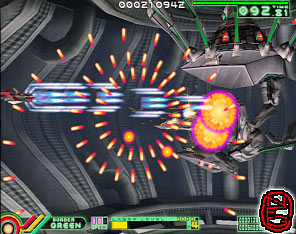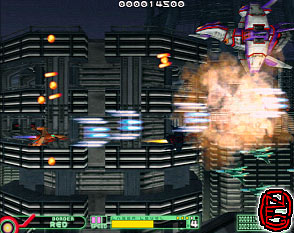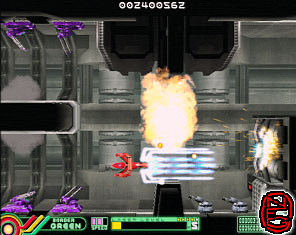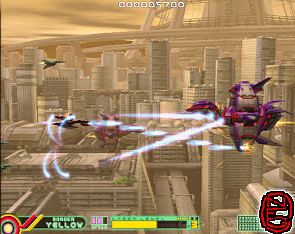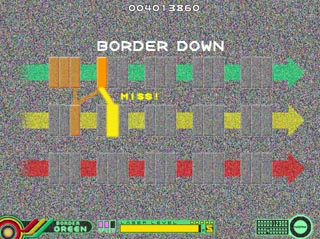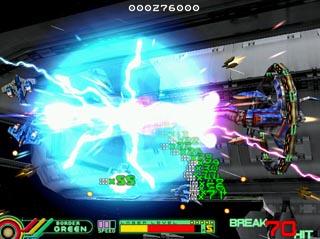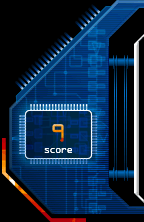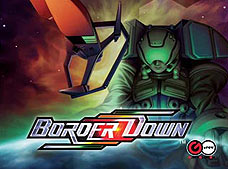|

BORDER
DOWN
2002
G.REV
Reviewed
by Randorama
A
BRIEF INTRO:
OR, LET'S TALK ABOUT PROCO AND TIAT
Border
Down, in case you wonder, was produced by a bunch of ex-Taito
guys: the president of the company, Mr.Maruyama, was one of the
project leaders on G.Darius and started working at Taito on Metal
Black. Yack (Yasuhisa Watanabe) is an ex-Zuntata member and also
worked on Metal Black. This explains why the game, basically,
plays like a sequel of the two games, more or less. No,sorry,
no giant fishes, but many ships look like they were taken from
Rayforce, and in fact Mr.Katoh (the designer) worked on that series
too.
WE
ARE IN THE AGE IN WHICH THE UNIVERSE IS NO LONGER JUST "
A PROMISED LAND".
Mars,
325 years after the colonization and terraforming of the planet:
"The seed" have sown. Aside the funny engrish, the game
is set in the future, when Mars is a planet inhabited by millions
of human beings. One day, like in all good hard sci-fi shmups,
the bad aliens show up and try to kick in the ass the poor humans
without even talking ( too many games to quote here ;Q ). The
alien force is then named "F.A.", acronym for "First
Approach": the first encounter happens in the Vesta mining
camps, outside the asteroid belt between Mars and Jupiter.Thy
don't try to make any contact at all: just attack everything human-related.
To fight this new treat, the " S.D.F.", Solar Defense
Force, has been formed. The Solar Defense Force then uses the
new "R.A.I.N", Remote Artificial Intelligence Network,
force: a trio of ships controlled via virtual reality by a human
pilot. These three ships are the "Antares XX-Wasp",
whose insect name is like "Mosquito" from Mars Matrix,
another game set on a colonized Mars. The story revolves around
those weird alien beings attacking Mars with some unknown weapon,
without any reason at all.So, S.D.F. sends their new weapon against
them...
The
three main characters are :
-
Lt.Frank
Boyd, the blonde hero;
-
Maya
Komarov, the mysterious girl which seems to have some commander
grade, but whose role isn't revealed during the game;
-
Colonel
Eiji Bowman ,Frank's superior and mischievous schemer.
Now,
the stages are also integral to the plot: well, actually the first
three stages are a simulation, the last three are the real (and
first ,for Frank) battle. Stage 1 and 2 are simulations based
on the first approach, while stage 3 is a simulation of a space
fight between S.D.F. and F.A. fleets. At the end of this stage,
you basically fight your other vehicles: this is actually an hint
of things to come...I can't tell you more. Stages 4 and 5 are
actual fights against F.A., the first in an abandoned colony,
the second on the orbital elevator . Now, every of the four ending
stages add something to the plot, so i can't tell you more...
A
very interesting thing is that you get a different "game
over" screen based on the stage you died in, whereas the
four different endings seem to hint that (provided that you complete
them in the alphabetic order) they're actually connected...or
perhaps not.
GRAPHICS
OR:"SO,HOW SHEFFIELD LOOKS LIKE IN THE 325TH YEAR OF MARS COLONIZATION?"
Well...A
characteristic of Taito games that G.Rev make theirs is the lack
of very defined graphics. Starting from the first Darius, Most
of Taito games have always got a nice design but usually not excellent
graphics. Let me clarify this issue: the Darius series, and also
the Rayforce series had a very cool design style, the former
with their fish-like enemies and the latter with their retro
mechas and Harlock-like ships. These games also had lots of nice
graphical effects, like rotations, scalings and stuff: still,
the basic drawings weren't the best you could find around. Now,
this bad habit continued in this title: While the graphics are
all polygon-based, in many points their quality isn't excellent.
Just one example: the first stage is set in Sheffield, the capital
of Mars Federation.
The
design is excellent, a nice city rendered with many details and
a a nice parallax effect. In the second section, you get down
in the sewers ( I think) to battle the mid-boss, then back in
the street level to fight the boss. If you change borders, you'll
get a yellowish sunset on yellow and a nice night view on red.
If you choose the remix version, you'll also get a nice snowing
effect on the border set at night (yellow one). Now, what you
will notice while playing the game is that the graphics aren't
ultra-smooth: here and there you'll get the sensation that they
(the gfx staff) could have worked a bit more on details, taking
out some pointy edges here and there. Second stage is set in the
said Vesta mining camps: this is where details seem scarce, especially
in the second section of the stage: nonetheless, the general design
is quite good, and heavily reeks of the 80's horzies, especially
of a little known series known as Thunderforce (eh, just kidding!
Actually source is so obvious, you should have lived in a black
hole not to know it ;) ) .
The
stage ends with a claustrophobic boss battle, where you fight
an alien-like thing which stands upside down and then falls on
the floor, where you should finish it off. After that, you go
in the third and final part of your fight simulation, a battle
against two enemy fleets (one of them probably are is yours, but
you may not be sure of it... );and the game finally starts to
shine. Backgrounds in this part rock ,either you have the cuiper
belt and its asteroids on the background, or the two fleets fighting
fiercely, with ships blowing while you blast up stuff (and having
some slowdown): in case you don't get the various homages, the
green border, in its first section, is basically an homage of
Vulcan Venture and later Gradius chapter, obviously the ice blocks
stage (third one, in said Vulcan Venture).On yellow and red borders,
the battle pays homage to tons of anime and games with such themes,
but the closest reference is Raystorm, fourth stage.
By
this stage you should have noticed what's the problem with G.Rev:
they seem not to be able to do smooth bigger objects. All of the
bigger objects in the games seem to be a bit edgy and "squared",
making me think more of a late psx game than a Dreamcast game
(more on this later).Still, the rest of stage, especially the
boss battle, is excellent: during the boss battle you’ll either
have a breathtaking Mars rendition of nebulosae and ships moving
around you, while you have an intense fight with some ,uhm, weird
thing similar to your ship but with an helping pods and then some
gigantic rotating arms. Aside this weird boss, you move to your
first real mission (perhaps), where you move around the various
sections of an abandoned space station: first section is different,
and equally good, for all borders: in the second section, you'll
fight a huge space ship/rocket, which is actually very impressive,
graphically-wise: in the final part, you'll see it exploding
and the boss coming out of it: highly dramatic cinematic sequence,
weird and cool boss, and...look at the circular panel on the background.
It isn't circular actually, but a figure with "n"
sides .I mean: the boss battle is beautiful, you fight a weird
disk-like thing while moving in the central toroid of the station,
you can see deep space and debris floating, and the details appear
rough in places...Bah.
Stage
5 is indeed beautiful, and problems are the same. First section
is a view of your ships going up the orbital elevator (the thing
you seeing covered by fog in the intro and in the first stage)
with a propulsor rock under their belly, like in Metal Black's
first stage and first bonus stage (NOTE: this isn't the only Metal
Black homage, but the only one quite obvious).In the second section
you have different routes to enter in the top part of elevator:
as always, you'll notice rough details and beautiful ideas (on
yellow border, you'll circle around the tower while battling a
Corona Coronet and seeing others of them moving in the background.
Boss battle is actually well done, even if the boss follows the
"weird ship" concept: if you figure out what it is,
let me know. Now, to avoid spoilers, some brief words about the
final stages: 6a and 6b, since they're set in the enemy's lair,
have a nice Side Arms homage, and a marvelous intro. 6c and 6d
have a beautiful setting for the final battle, and that's all
I can say. So...
SUMMARY
OF SUBSECTION:
The
game could have been better in the graphical department, in some
points it really shines, While in others it's a bit rough: same
thing can be said for design. Bottom point: it could have been
better, still it's very well done and solid.
PARTIAL
VOTE : 8.
AUDIO
OR: "SHEFFIELD SHUFFLE"
(NOTE:
Names are taken from the CD that comes with LE).
The
BGM is perhaps the most difficult and trickiest part to do in
a game - luckily G.Rev could count on one of the Zuntata founders,
its guitarist (unless I recall wrongly) Yasuhisa Watanabe, known
as Yack.
His
most famous works are Metal Black (91), Dan-ku-ga (95) and Elevator
Action Returns (96).Back in the '90s, Zuntata were famous enough
to launch their own discographic label and put their symbol on
Taito games as a trademark of good soundtracks. While the most
famous Zuntata guys are usually OGR (Hisayoshi Ogura, he did ninja
warriors(87) and all the Darius games, and Tamayo Kawamoto (she
did all the Rayforce games), Yack has been using the the most
diverse styles in his soundtracks. Border Down is probably the
best example: basically what this soundtrack misses is some hip-hop
and heavy metal, if we want to make a list of possible genres
for a BGM. Most of the soundtrack, so to speak, is basically a
light form of modern jazz and fusion, catchy and simple enough
to fit the game's atmosphere without being too complex and distracting.
Stage
1 and 2 have nice Zuntata-like themes (what I would basically
define as " '80s j-pop with a strong arcade flavour":
sorry, if you're not a Taito fan from their early days, you may
not get what I mean),named "Upon the new raid" and "
Girl of Power". First boss theme, "Eyes", is also
in this style, and reeks heavily of earlier Zuntata works. The
second boss has instead a nice and hypnotic jungle/drum'n’bass
theme, "Blade action", that fits nicely with the cramped
fight you have with the said baddie.
On
stage 3, you have an excellent jazzy theme for green border,"Bye
Bye Mars":if you don't like it, you may border down to yellow
and red borders, where you get a trancey tune that sounds like
Underworld made it :then you have another dance tune for the boss,
which also sounds very Zuntata-ish. In stage 4 style changes to
suit the "space-themed tv series" setting, and thus
you get two different orchestral themes: "Lost temple"
and "Border Line".
The
boss theme ("Cage") is something completely different:
it sounds like an Aphex Twin song, especially the children's voices
and other weird sounds popping up here and there, and it blends
perfectly with the "weird space thing" battle setting.
Stage 5 has an incredible fusion theme, "Snow fox":
easily the best song in the BGM, with its melancholic mood and
its splending refrain. Just to avoid other spoilers, let's say
that 6a and 6b have a nice and dramatic orchestral theme, whereas
6c and 6d have a lullaby-like theme and the reprise of one song
not related to any stage for the final battle. The Border Down
BGM is basically a collection of styles, very atmospheric and
original. While it's not by {insert name of fanboys' favourite
artist here}, it still manages to suit perfectly the various settings
present in the game, albeit it may be a bit too "dispersive"
if you don't like some of the genres. Some notes on the BGM CD
that comes with the Limited Edition: what the hell...couldn't
they have put the "remix versions" songs too? Bah...rest
is sweet, especially the rearranged tunes. If you want the said
missing songs, please let me know.
SUMMARY
OF SUBSECTION:
Perfect
soundtrack, it does flawlessly what every BGM should be: providing
an atmospheric and pleasant musical comment to action. You may
not like it if you're not into many of the genres used in it,
or you basically don't like Zuntata.
PARTIAL
VOTE: 10.
GAMEPLAY
OR:"CRUSHING
BLOW"
Ok,
everything you would like to know about the gameplay is explained
in detail in the ST
I wrote in the strategy section
At
any case, I'm writing a synthetic description of gameplay in this
section. You basically have two normal attacks (A button),one
special attack (B button) and a speed control (C button). Now,
all attacks depend from your power level, the nice yellow bar
at the bottom of the screen. This bar automatically refills with
time, and every time you shoot down an enemy with normal shots.
Its level ranges from level 1 (pea shooter) to level 5 (powerful
stream).You have two normal attacks: if you tap A button, you
will shoot a central laser and some homing lasers (1 and 2 for
levels 1 and 2, then 4,6 and 8 homing lasers for levels 3,4 and
5 of power).If you hold down the button, you will shoot a coherent
frontal stream. The closer you're to an enemy, the higher the
fire rate (like in Darius games!).If you use the B button, you
will use the special weapon, the Break Laser.
Break
Laser automatically consumes half a bar of energy per usage, plus
roughly another bar every 3 seconds.The first four seconds you
use it, you will be invincible, then you will be vulnerable again.
With the break laser, you can cancel bullets (see the ST to see
the advantages) and destroy enemies, and you can do a laser fight
with other enemies shooting laser (in a G.Darius alpha/beta beam
style, but creating a giant sphere of energy like in Metal Black).Using
the laser to cancel bullets is the key for big scores: you will
get a multiplier per every bullet cancelled, and it will go to
destroyed enemies' points. For instance, if you cancel 10 bullets
and destroy an enemy worth 300 points, it will be worth 300x10=3k
points.
Now,
the game is named "Border Down" because it has a new
approach to level design: you can choose, at the beginning, your
border to start the game on. Every stage has 3 borders: green,
yellow and red ("easy","middle class","maniac"
difficulty).
Every
time you get hit, you will move one border down, and thus go from
green to yellow border, then from yellow to red, then it's game
over if you get hit on red border. This doesn't mean that the
game becomes more difficult: this because it has a rank system,
which will increase difficulty the more time you're alive. Also,
you will have a "Norm clear" value, which is a way to
go up one border after a stage: it's basically a given score to
get on a single stage. One example: you start from yellow border
on stage 1. You clear the stage and do 12M points, enough to get
the Norm clear (which varies: red has always the highest score
for Norm Clear). At stage 2, you can choose to move up one border
(and start on green),remain on yellow or go down on red. It's
obvious that at the beginning you will like to stay on green as
much as possible, since it means you can die (border down) two
times before losing. Now, we said there's rank: the more you survive
on one life, the harder the game gets. Also, every time you get
a Norm Clear (you extend, basically), the rank will go up. The
more Norm Clears you get, the higher the increase: at the sixth
norm clear, you get a +60% (rank is a percentual ranking from
0 to 100%). At least, you get a x2 multiplier on everything on
yellow border, and a x3 on red. Also, the amount of time you spend
on a single border will determine what final stage you get:
-
Less
than 4 Norm Clears and/or less that 50% of the time of any border:
6A.
-
More
than 4 Norm Clears and at least 50% of the time on green border:6B.
-
More
than 4 Norm Clears and at least 50% of the time on yellow border:6C.
-
More
than 4 Norm Clears and at least 50% of the time on red border:6D.
Since
every stage is divided into 3 sections (first half, second half,
boss), if you clear more than 75% of a section, you will border
down to the next section. Last but not least, you can choose your
own speed: speed one is raiden-like clumsiness, speed 2 is good,
speed three is usually the way to go. Be careful! you won't explode
immediately if you collide again a wall, but the faster you are,
the less time of collision you need to explode. Also, your hitbox
is the cockpit, regarding bullets. One thing: it's a one-player
matter, so no team shmuppin', sorry.
SUMMARY
OF SUBSECTION.
Gameplay
and scoring system are nicely intertwined and work smoothly, they're
easy to grasp and hard to master. The style is more like early
'90s games, where the "strategic" elements and original
mechanics played a more important role than huge chains. It's
basically a perfect mix of old and modern "skools",
so to speak, or perhaps a "modern classic". Highly recommended
for everyone, but be careful of boss battles, they can be very
tricky and rewarding at the same time.
PARTIAL
VOTE: 10.
LONGEVITY:
THEY'RE
STILL FLYING...IF I "DOWNLOAD" IT NOW
Well:
I'll be honest. If you click with the game, you may it play for
ages. If you don't, it will collect dust after a few tries. In
between, it largely depends on your skills. Rank system and the
different paths basically can give you a constant and growing
challenge, but still...it depends on your skills. The game is
basically one giant boss battle with nice stages in between, and
this may also not be your cup of tea: of the half an hour you
should take to complete the game, at least 15 are spent taking
down the bosses (70+100+130+120+180+240/300 seconds=14/15 minutes
spent on battling big baddies!).
Now,
boss battles can be fun even if you just want to blow up stuff
quickly: you can go on practice mode and blast those baddies.
Speaking of practice mode, you can get exercise on single sections
by using this mode and choosing the proper rank level. There's
also an entire remix mode (the equivalent of "extra"
versions of the past),which works in a slightly different way...There
are cosmetic changes, most of the mid-bosses and bosses have different
attacks, there are no green carriers releasing energy, instead
all violet ones do this, also most of the enemies shoot more bullets,
and finally the true mission stages have borders "shuffled"
( 4.1 G is 4.1 R of normal mode).
Now:
I would like to give a 10 to this section too, but an objective
consideration is this: if you're not a score whore and you can't
manage properly the intimidating rank system, chances are that
you won't get past a completion of the simplest route, 6a, if
you care of course. Boss Battles are what you'll play most if
you just want a quick blast, something akin to the psx port of
G-Darius. If you liked Zuntata and most of Yack's work, and you
didn't buy the L.E., you'll also play the game just to listen
to the music, every once in a while.
SUMMARY
OF SUBSECTION.
The
game has lots of replay value, but at some point ,if you're not
obsessed with score, you may be interested just in boss battles,
milking given sections and listening to the Soundtrack. The remix
version offers some more new challenges, but once you've done
with it, the same principles for normal version work.
PARTIAL
VOTE: 9.
FINAL
NOTES:
WE
DON'T KNOW...THE TRUTH OF THE MATTER YET.
Border
Down for Dreamcast is an excellent port: aside being arcade-perfect,
it has a lot of "omake" (extras, but it's not the right
translation!), an extra version, a Limited Edition with a Soundtrack
CD. The game is an unofficial descendant of the glorious Taito
lineage, and it plays like a modern version of some of the classic
shmups of early '90s, more of all of G.Darius. The game may not
appeal to people who diss horizontal shmups not based on memorization
(like the R-type school), or people that don't like rank (see
above).Anyone who liked the Taito shmups of the past will probably
like this one: also, the fact that G.Rev, its programmers, are
basically ex-Taito programmers is pretty obvious once you play.
Last but not least,the game offers lots of fun for those who like
epic boss battles.
FINAL
VOTE: 9+.
Not
perfect, but above the minimum threshold for a masterpiece, in my
book. Buy it now and have fun =)

|







